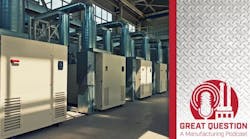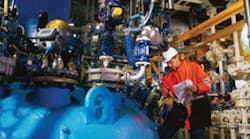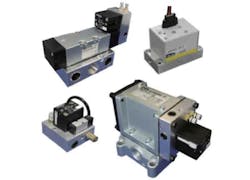Compressed air systems and tools have been widely used in manufacturing for many decades for a staggering array of applications, but they are often overlooked when facilities engineers are considering ways to reduce overall energy consumption and energy costs. In many industrial facilities, air compressors use more electricity than any other type of equipment, so the potential for saving from reducing energy usage in compressed air systems can be significant. Energy savings from system improvements can range from 20 to 50 percent or more of electricity consumption. For the largest facilities, this can add up to hundreds of thousands of dollars in potential annual savings, depending on use.
Energy audits conducted by the U.S. Department of Energy have indicated that more than 95 percent of industrial compressed air systems present opportunities for saving energy. In addition to obvious sources of energy waste such as leaks in the compressed air system, more than 30 percent of a plant’s air costs can be associated with inappropriate uses of or artificial demand for compressed air.
The overall efficiency of a typical compressed air system can be as low as 10 to 15 percent. For example, approximately 7-8 hp of electrical power must supplied to the air compressor to operate a 1 hp air motor at 100 pounds per square inch gauge (psig). Use this formula to calculate the cost of compressed air in your plant:
| Cost($)=(bhp)*(0.746)*(Number of Operating Hours)*($/kWh)*(%time)*(%full-load bhp) Motor Efficiency |
Where:
- bhp—Motor full-load horsepower (frequently higher than the motor nameplate horsepower—check equipment specification)
- 0.746—conversion between hp and kW
- Percent time—percentage of time running at this operating level
- Percent full-load bhp—bhp as percentage of full-load bhp at this operating level
- Motor efficiency—motor efficiency at this operating level
Almost half of all the compressed air used in industrial plants goes to air blowing activities like drying parts, removing debris that has settled on them, blowing them off a conveyor, etc. In these applications, it’s common to discharge air continuously, even when no parts are present. Air audits Parker has conducted have revealed that the use of uncontrolled blow-offs (that is, releasing a continuous stream of compressed air through a nozzle) is one of the top air consumption issues on factory floors.
Because of the high costs associated with constant flow compressed air systems, more and more manufacturers are considering more energy-efficient alternatives. One of the most economical approaches is the use of a valve that converts a continuous air blow to a pulsed air blow with no need for any other external control. Air is blown in a high-speed series of on and off pulses. When the blow is off, there is no air consumption, so fewer tank recharging cycles are required.
This pulsed air flow approach offers manufacturers several advantages, not the least of which is a 40 to 50 percent reduction in compressed air costs when compared with typical constant flow systems. Unlike a continuous stream of air, a pulsed air blow strikes the part repeatedly, improving the efficiency of the air blow for drying and removing debris from resin molded parts prior to coating or finishing surfaces. A pulsed air flow system can also reduce the level of greenhouse gases a plant produces by lowering its CO2 emissions associated with producing compressed air, which, for organizations striving to meet new sustainability standards, can help them meet their objectives.
Another important advantage of the pulsed compressed air approach to consider is its relatively quick return on investment. Many systems currently use solenoid valves to control air blow; in these cases, a facilities engineer can simply replace them with pulsed air blow valves, with no need to make any programming changes to the PLC controlling the air blow point (Figure 1). In applications currently employing manual valves such as ball valves, passive valves are available that require no electricity to power them, further increasing energy efficiency. Fast, simple installation means there’s no need to compromise production schedules.
Figure 1. A typical pulsed air valve, such as the Parker Hannifin Air Saver Unit shown here,
can be used as a drop-in replacement for a solenoid valves in a variety of applications.
Figure 2. Pulsed air switch valves are available with a wide range of flow capacities. For example,
Air Saver Units offer flows (at 5 bar) ranging from 150 to 15,000 liters/min. Other features include
an adjustable pulse frequency and duty cycle, a silicon-free grease version for paint shop applications,
and an on time/off time adjustment needle.
Pulsed Air Blow Applications
Pulsed air blow valves are proving their value in a growing range of industries, including soft drink bottling. One major Chinese soft drink manufacturer uses them for a variety of applications, including removing particulates more efficiently in their PET (polyethylene terephthalate) bottle plants, both before and after the blow molding process. Each blast of pulsed ionized air agitates unwanted waste particles for more efficient removal and reduced cycle time. Pulsed air can also provide an assisting blow to convey bottles, as an escape blow for when the line has stopped and before attaching labels to them. This manufacturer saw a 45 percent reduction in air consumption and associated costs for energy use. With no changes to the PLC program, the Air Saver Unit has proven to be a cost -effective solution that was retrofitted to their existing production line providing an immediate reduction in air consumption without any further cost outlay.
Pulsed air blow valves are also suitable for other applications in a wide array of industries:
- Electronics: Cleaning surfaces or components prior to assembly.
- Swarf removal: Swarf (sometimes called turnings, filings, or shavings) is made up of the small pieces of metal, wood, cardboard, plastic, etc. produced as waste from machining, woodworking, or other subtractive manufacturing processes. A pulsed air blow system can keep swarf away from working machinery and direct it into collection/recycling containers.
- Printing: Pulsed air blow offers a fast way to ensure surfaces to be printed are fully dry before printing begins.
- Cooling: Pulsed air blow systems offer a fast, inexpensive forced convection cooling option.
For more details on how pulsed air blow systems can reduce a manufacturing facility’s energy costs and CO2 emissions, watch this YouTube demonstration titled “Parker Hannifin Air Saver Units cut energy consumption by 50%”:
Biographical Note
Richard McDonnell is market development manager at Parker Hannifin’s Pneumatics Division N.A., where his focus is on the identification, qualification, and development of new products and technologies.












